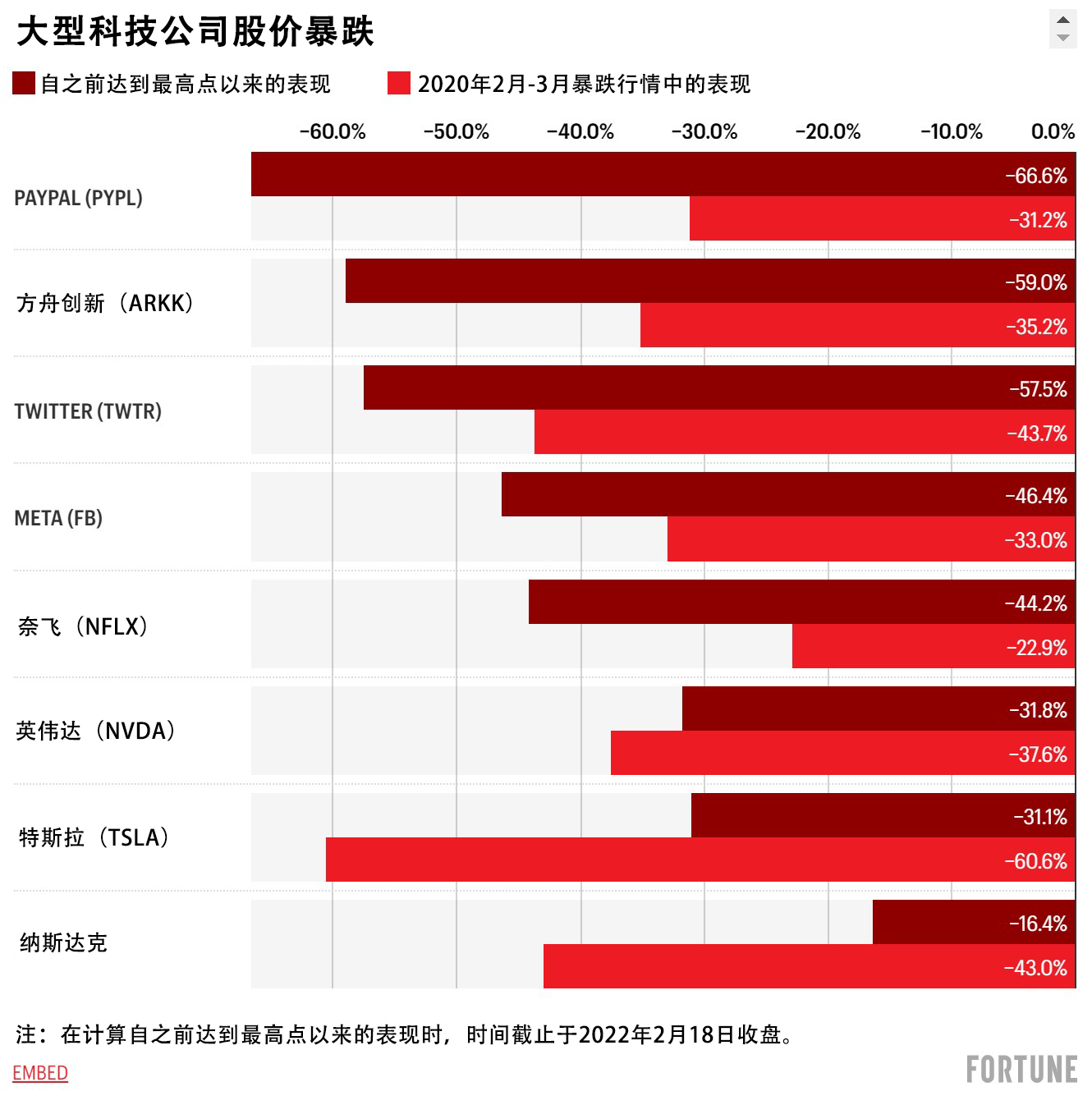臨近2020年年底,在新冠疫苗即將大規模上市的消息傳出后,華爾街開始警告投資者注意新的市場動態。華爾街認為,高成長科技股將不再是投資者的最愛。取而代之的是被低估的價值股,比如能源板塊和消費板塊等將重新成為投資熱門。
華爾街的預測非常準確。
2022年到目前為止,高價科技股持續走低,納斯達克指數從年初至今下跌14.4%,與2021年11月中旬發達國家爆發奧密克戎疫情之前的史上最高點相比下跌了16.4%。
當然,不會有選股專家認為科技股已經觸底。
位于美國納什維爾的投資研究公司New Constructs的首席執行官戴維·特雷納告訴《財富》雜志:“雖然市場上有許多估值合理并且實現盈利的公司,但有更多的公司估值嚴重過高且沒有盈利,這些公司的股價還會進一步下跌,甚至有些股票可能跌至零。”
即使在奧密克戎疫情爆發之前,已經有投資者對大批成長股唯恐避之不及,例如Zoom、PayPal以及凱西·伍德的方舟創新ETF基金(Ark Innovation ETF)所投資的公司。這些公司在2020年下半年股價暴漲。
投資者聽到這些公司收入增長放緩的風聲之后,便開始套現離場。世界衛生組織宣布新冠疫情為全球大流行之后,2020年2月和3月美國股市崩盤,但與之相比,最近的科技股暴跌對于投資者投資組合的破壞更加嚴重。
PayPal、Netflix和Meta股價暴跌
PayPal受到了投資者的懲罰。其股價在2月18日收于103.65美元,比其2020年新冠疫情之前的高點下跌了15%。PayPal股價暴跌的幅度令人難以置信。其股價在2020年3月跌至低點,但在隨后15個月,隨著使用量和收入激增,其股價上漲了超過兩倍。但隨著增長停滯,其股價開始迅速暴跌,市值縮水了數十億美元。
這家專業數字支付公司的估值從2021年夏季中期的史上最高點減少了三分之二。股價暴跌尤其讓看好PayPal的投資者痛苦不已。過去七個月的股價跌幅,是2020年2月和3月的兩倍。
如下表所示,有類似行情的不止PayPal一只股票。
Netflix、Facebook母公司Meta和推特(Twitter)等公司的股價在最近一輪暴跌中的跌幅,均超過了新冠疫情初期的跌幅。圖中的淺紅色代表2020年2月至3月的股價跌幅。我們將其稱為第一輪暴跌。深紅色代表股票在第二輪暴跌中的跌幅,按照其從最近的史上最高點到今年2月18日收盤價的下跌幅度計算。

有一只股票在圖中并未出現,它就是Moderna。這家疫苗公司在納斯達克上市,其股價自2021年8月創歷史新高以來下跌了71%。它也代表了投資者曾經對于成長股的熱情,只是這種熱情現在已經消失殆盡。
上漲,下跌,循環往復
如果說三十年前的互聯網泡沫破滅讓投資者得到了一些教訓,那就是科技股很容易陷入漲跌周期。上周末,里薩茲財富管理公司(Ritholtz Wealth Management)的投資組合經理、《財富》雜志的專欄作家本·卡爾森在一篇博客中嘗試回答一個發人深省的問題:科技股需要多久才能反彈?
壞消息是,從歷史記錄來看情況不容樂觀。他指出,微軟股價用了16年才恢復到1999年的歷史最高水平,英特爾和思科的股價依舊低于其輝煌時期的價格。
他寫道:“科技股之所以容易陷入漲跌周期,是因為創新總是會產生泡沫。我們只是無法控制自己。”
他繼續寫道:“我并不是說目前暴跌的科技股也會經歷類似的漫長寒冬。但成長股的投資者也不要認為暴跌50%至80%的股票都會迅速反彈,再創新高。”
通過分析2021年的行情,可以看出納斯達克成分股最近幾個月的表現是多么糟糕。卡爾森在一條推文中公布了一條壞消息:
納斯達克綜合指數涵蓋的股票從52周高位以來的表現:
一半股票下跌30%或以上
40%的股票下跌40%或以上
35%的股票下跌50%或以上
28%的股票下跌60%或以上
——本·卡爾森(@awealthofcs),2022年2月18日
趁跌買入?
即使經過暴跌,分析師依舊認為許多科技股的估值過高。
特雷納表示:“對于Meta Platforms、推特和英偉達(Nvidia)等科技股,我們認為現在還只是出現了投降式拋售的早期跡象,未來還有更大的下行風險。”他還對網紅股提出了質疑。備受Reddit散戶投資者喜愛的Robinhood、AMC娛樂(AMC Entertainment)和Bed Bath & Beyond分別從其史上最高點下跌了86%、75%和69%。
特雷納的建議是堅決遠離網紅股。
他補充道:“無論最近的投資趨勢是什么,基本面始終是最重要的。網紅股投資者并不明白這一點,而且坦白說,他們可能永遠也不會明白。”(財富中文網)
譯者:劉進龍
審校:汪皓
臨近2020年年底,在新冠疫苗即將大規模上市的消息傳出后,華爾街開始警告投資者注意新的市場動態。華爾街認為,高成長科技股將不再是投資者的最愛。取而代之的是被低估的價值股,比如能源板塊和消費板塊等將重新成為投資熱門。
華爾街的預測非常準確。
2022年到目前為止,高價科技股持續走低,納斯達克指數從年初至今下跌14.4%,與2021年11月中旬發達國家爆發奧密克戎疫情之前的史上最高點相比下跌了16.4%。
當然,不會有選股專家認為科技股已經觸底。
位于美國納什維爾的投資研究公司New Constructs的首席執行官戴維·特雷納告訴《財富》雜志:“雖然市場上有許多估值合理并且實現盈利的公司,但有更多的公司估值嚴重過高且沒有盈利,這些公司的股價還會進一步下跌,甚至有些股票可能跌至零。”
即使在奧密克戎疫情爆發之前,已經有投資者對大批成長股唯恐避之不及,例如Zoom、PayPal以及凱西·伍德的方舟創新ETF基金(Ark Innovation ETF)所投資的公司。這些公司在2020年下半年股價暴漲。
投資者聽到這些公司收入增長放緩的風聲之后,便開始套現離場。世界衛生組織宣布新冠疫情為全球大流行之后,2020年2月和3月美國股市崩盤,但與之相比,最近的科技股暴跌對于投資者投資組合的破壞更加嚴重。
PayPal、Netflix和Meta股價暴跌
PayPal受到了投資者的懲罰。其股價在2月18日收于103.65美元,比其2020年新冠疫情之前的高點下跌了15%。PayPal股價暴跌的幅度令人難以置信。其股價在2020年3月跌至低點,但在隨后15個月,隨著使用量和收入激增,其股價上漲了超過兩倍。但隨著增長停滯,其股價開始迅速暴跌,市值縮水了數十億美元。
這家專業數字支付公司的估值從2021年夏季中期的史上最高點減少了三分之二。股價暴跌尤其讓看好PayPal的投資者痛苦不已。過去七個月的股價跌幅,是2020年2月和3月的兩倍。
如下表所示,有類似行情的不止PayPal一只股票。
Netflix、Facebook母公司Meta和推特(Twitter)等公司的股價在最近一輪暴跌中的跌幅,均超過了新冠疫情初期的跌幅。圖中的淺紅色代表2020年2月至3月的股價跌幅。我們將其稱為第一輪暴跌。深紅色代表股票在第二輪暴跌中的跌幅,按照其從最近的史上最高點到今年2月18日收盤價的下跌幅度計算。
大型科技公司股價暴跌
深紅色:自之前達到最高點以來的表現
淺紅色:2020年2月至3月暴跌行情中的表現
注:在計算自之前達到最高點以來的表現時,時間截至2022年2月18日收盤。
有一只股票在圖中并未出現,它就是Moderna。這家疫苗公司在納斯達克上市,其股價自2021年8月創歷史新高以來下跌了71%。它也代表了投資者曾經對于成長股的熱情,只是這種熱情現在已經消失殆盡。
上漲,下跌,循環往復
如果說三十年前的互聯網泡沫破滅讓投資者得到了一些教訓,那就是科技股很容易陷入漲跌周期。上周末,里薩茲財富管理公司(Ritholtz Wealth Management)的投資組合經理、《財富》雜志的專欄作家本·卡爾森在一篇博客中嘗試回答一個發人深省的問題:科技股需要多久才能反彈?
壞消息是,從歷史記錄來看情況不容樂觀。他指出,微軟股價用了16年才恢復到1999年的歷史最高水平,英特爾和思科的股價依舊低于其輝煌時期的價格。
他寫道:“科技股之所以容易陷入漲跌周期,是因為創新總是會產生泡沫。我們只是無法控制自己。”
他繼續寫道:“我并不是說目前暴跌的科技股也會經歷類似的漫長寒冬。但成長股的投資者也不要認為暴跌50%至80%的股票都會迅速反彈,再創新高。”
通過分析2021年的行情,可以看出納斯達克成分股最近幾個月的表現是多么糟糕。卡爾森在一條推文中公布了一條壞消息:
納斯達克綜合指數涵蓋的股票從52周高位以來的表現:
一半股票下跌30%或以上
40%的股票下跌40%或以上
35%的股票下跌50%或以上
28%的股票下跌60%或以上
——本·卡爾森(@awealthofcs),2022年2月18日
趁跌買入?
即使經過暴跌,分析師依舊認為許多科技股的估值過高。
特雷納表示:“對于Meta Platforms、推特和英偉達(Nvidia)等科技股,我們認為現在還只是出現了投降式拋售的早期跡象,未來還有更大的下行風險。”他還對網紅股提出了質疑。備受Reddit散戶投資者喜愛的Robinhood、AMC娛樂(AMC Entertainment)和Bed Bath & Beyond分別從其史上最高點下跌了86%、75%和69%。
特雷納的建議是堅決遠離網紅股。
他補充道:“無論最近的投資趨勢是什么,基本面始終是最重要的。網紅股投資者并不明白這一點,而且坦白說,他們可能永遠也不會明白。”(財富中文網)
譯者:劉進龍
審校:汪皓
Towards the end of 2020, once we learned a COVID-19 vaccine was ready for the masses, Wall Street began to warn investors of a new markets dynamic. High-growth tech stocks would fall out of favor with investors, the message went. In its place, overlooked value stocks—think energy and consumer staples—would make a comeback.
Wall Street nailed the forecast.
So far in 2022, once high-flying tech stocks are taking it on the chin, with the Nasdaq down 14.4% year-to-date, and down 16.4% since hitting an all-time high in mid-November, just before the Omicron wave arrived to batter the developed world.
To be sure, very few stock-picking pros are calling this the bottom.
"While there are plenty of reasonably valued and profitable companies in the market, there are many more dangerously overvalued and unprofitable companies whose stocks could fall much further, and some even to zero," David Trainer, CEO of Nashville-based investment research firm, New Constructs, tells Fortune.
Even before Omicron, investors were treating a large basket of growth stocks—names like Zoom, PayPal and the companies you'd find in Cathie Wood's Ark Innovation ETF, all of which soared during the latter half of 2020—as if it were the plague.
Once investors got a whiff that top-line growth for these companies was slowing, they started to cash out. In many cases, the latest rout in tech stocks has been far more damaging to investor portfolios than what we saw during the stock market collapse of February and March 2020, just after the World Health Organization declared COVID to be a pandemic.
PayPal, Netflix and Meta in freefall
PayPal is one such company that's getting punished by investors. The stock closed on February 18 at $103.65, 15% below its 2020 pre-pandemic high. The collapse in PayPal shares has been nothing short of breathtaking. From its March, 2020 low, shares more than tripled over the next 15 months as usage and revenues soared. And then, just as quickly, the shares collapsed, shedding billions in value as growth started flatlining.
The digital payments specialist has now lost two-thirds of its value since its mid-summer 2021 all-time high. The gutting loss has been particularly painful for PayPal bulls. The share-price collapse over the past seven months has been twice as dramatic as what investors saw in those dark days of February and March 2020.
As the chart below shows, PayPal is hardly alone.
Netflix, Facebook parent Meta, and Twitter have also seen bigger hits to their share prices in this latest round of sell-offs than what occurred in the early days of COVID. The light-colored red line in the chart measures the share sell-off during the epic February-March 2020 sell-off. Let's call that Round One. The darker red line above measures the Round Two carnage, calculated as the share-price performance of these stocks since their most recent all-time high and February 18's closing price.
One stock that's not on the chart: Moderna. The Nasdaq-listed vaccine specialist, and a symbol of investors' now-dashed exuberance for growth-stocks, is down 71% since its August all-time high.
Boom, bust, repeat
If investors learned anything from the dot-com sell-off a generation ago, it's that tech stocks are vulnerable to boom-bust cycles. On his blog this weekend, Ben Carlson, a portfolio manager at Ritholtz Wealth Management and a regular Fortune columnist, took a stab at answering the provocative question: How long does it take for tech stocks to recover?
The bad news: the historical record isn't great. He notes that it took Microsoft 16 years to return to its 1999 all-time high, and that Intel and Cisco still trade well below those glory days.
"Tech stocks," he writes, "are prone to these boom-bust cycles because innovation always causes bubbles. We simply can’t help ourselves.
"I’m not saying today’s tech stocks that are getting killed are in for a similar extended winter," he continues. "But growth investors also shouldn’t assume all of these stocks that are down 50-80% are going to be back at new highs in a hurry."
Zoom in to the last year, and you see just how bad the constituent parts of the Nasdaq are performing in recent months. Carlson lays out the bad news in the following tweet:
Nasdaq Composite stocks from 52 week highs:
Half of the stocks in the index are down 30% or worse
40% of stocks are down 40% or worse
35% of stocks are down 50% or worse
28% of stocks are down 60% or worse
— Ben Carlson (@awealthofcs) February 18, 2022
Buy the dip?
Even after such a sharp sell-off, analysts still see many of these hobbled tech stocks as too pricey.
"With some tech stocks like Meta Platforms, Twitter and Nvidia, we believe we are only seeing early signs of capitulation and there is plenty of more downside ahead from here," Trainer reckons. He also takes issue with meme stocks. A few darlings of the Reddit crowd—Robinhood, AMC Entertainment and Bed Bath & Beyond—are down 86%, 75% and 69%, respectively, off their all-time highs.
His advice: stay away from meme stocks. Far away.
"No matter what the latest investing trend is, fundamentals will always matter. The meme stock trader's don't understand this, and quite frankly, they may never understand this," he adds.






